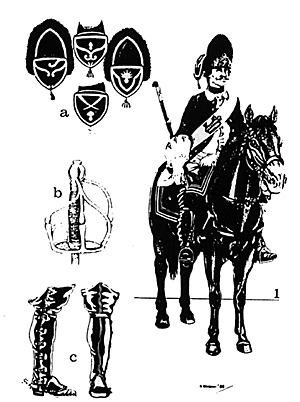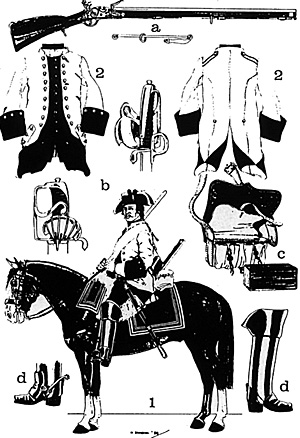Cavalry
Mounted Troops
The cavalry and dragoons were organized into 650-man, five squadron/ten company regiments (i.e. 130 men/squadron). The Gardes du Corps had only three companies but they were the same size as line cavalry squadrons. In 1744, a Carabinier company was created in each of the cavalry regimenls. And a fur-capped Horse Grenadier company was created in each of the dragoon regiments. However, these elite troopers were not often taken out of their parent units to act as a cavalry reserve as the Austrians often did with theirs.
 At left, Horse Grenadier from the Piedmont Dragoon Regiment. Pictures from Le Regie Truppe Sarde 1750-1773.
At left, Horse Grenadier from the Piedmont Dragoon Regiment. Pictures from Le Regie Truppe Sarde 1750-1773.
Coats were blue for the cavalry, and red for the dragoons. The cut was similar to that of the infantry ones but with two self-coloured shoulder straps to hold the carbine belt and the cartridge-box belt in place. All of the mounted units had buttons on both edges of their coats arranged 2-2-2-2-2. Pockets on vest and coat were vertical with 4 buttons. Cuffs, turnbacks, vest and breeches were in a distinguishing colour. (On campaign, leather breeches were probably worn rather than cloth, coloured ones of the distinguishing colour.) The cavalry had a white wool aiguillette hanging from the right shoulder, while the dragoons had red ones.
The cavalry were issued with white woolen cloaks lined in the distinctive colour, while the dragoons had red ones also lined in the distinctive colour. When not being worn, these were carried as saddle rolls.
 At right, Trooper (in buff coat) and his equipment from a Savoy Cavalry Regiment. Pictures from Le Regie Truppe Sarde 1750-1773.
At right, Trooper (in buff coat) and his equipment from a Savoy Cavalry Regiment. Pictures from Le Regie Truppe Sarde 1750-1773.
All neck stocks were black, as was the footwear, and the saddlery straps and reins. >
Sabres were straight for the Gardes du Corps and the for line cavalry but were slightly curved for the dragoons. Sabre and dragoon bayonet scabbards were black, with brass fittings for the cavalry ones and white metal for the dragoons'.
Dragoons had full-size muskets, but shorter carbincs were issued to the cavalry. Carabiniers had rifled carbines. These were either worn hanging from a wide, buff' crossbell over the left shoulder or held butt-first in a gun bucket attached to the saddle. A tasseled stopper was inserted in the barrel when in this position to stop water trom getting down the barrel. A narrower crossbelt over the right shoulder held the smallish, black cartridge box. Horse Grenadiers also had brass match-cases on their carbine belts.
Cavalry and dragoon shabraques were red, square ended and trimmed with a wide white border that was in turn piped on both edges by a blue stripe. This same pattern of trim, although narrower than on the shabraque, also edged the round holsters. There was no zigzag piping on this white borders during this period.
Guardie del Corpo/Gardes du Corps: Red coats; coat buttons arranged 1-2-3; pocket buttons were three, horizontal; three cuff buttons. Coat was heavily-laced in gold (buttons and buttonholes on coat and cuffs; edges of hat, coat and cuffs). They wore a blue crossbelt with both edges laced gold, with a snaking S-shaped line of gold lace down the centre. On campaign, they wore a leather soubreveste for protecting both body and expensive coat. (A bufalo in Italian, as in buff leather in English.) Shabraques were red, square-ended, and trimmed with a wide strip of gold lace. The King's gold, crowned CE monogram was on the shabraque's rear corner and on thc round holsters (which were trimmed with lace as on the shabraque but narrower).
Piedmont Dragoons: Wore red breeches.
| PIEDMONT 1741-51 | ||
|---|---|---|
| Mounted Troops | Distinctive Colour | Lace |
| Guardie del Corpo/Gardes du Corps | Red | Gold |
| Royal Piedmont Cavalry (1691) | Red | Yellow |
| Savoy Cavalry (1691) | Red | While |
| di S.M./His Majesty's Dragoons (1683) | Blue | Yellow |
| Piedmont Dragoons (1689) | White | White |
| di S.A.R./His Royal Highness' Dragoons (1690) | Green | White |
| della Regina/Queen's Dragoons (1736) | Sky Blue | White |
Back to Seven Years War Asso. Journal Vol. IX No. 1 Table of Contents
© Copyright 1996 by James E. Purky
This article appears in MagWeb (Magazine Web) on the Internet World Wide Web.
Other military history articles and gaming articles are available at http://www.magweb.com